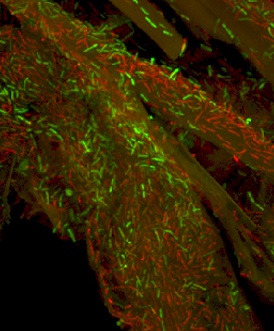02/05/2016
New Understanding of One of Nature’s Best Biocatalysts for Biofuels Production
Discovery of a new enzyme system sheds further light on a microbe’s ability to efficiently break down inedible plant matter for conversion to biofuels and biobased chemicals.

The microbe Clostridium thermocellum (stained green) is seen growing on poplar tissue.
Image courtesy of Oak Ridge National Laboratory
The Science
Researchers found that Clostridium thermocellum—an anaerobic, thermophilic microorganism—uses a previously unknown mechanism to degrade cellulose (scaffolded cellulase enzymes not attached to the bacterial cell wall), in addition to other known degradation mechanisms (cellulosomes and free enzymes).
The Impact
This discovery helps explain C. thermocellum’s superior ability to digest biomass and demonstrates the highly diverse strategies evolved in nature for biomass conversion. Researchers are using the study’s findings to develop optimal systems for breaking down lignocellulosic biomass to produce biofuels and biobased chemicals.
Summary
Lignocellulosic biomass is the largest source of organic matter on Earth, making it a promising renewable feedstock for producing biofuels and chemicals. Currently, however, the main bottleneck in biofuel production is the low efficiency of cellulose conversion, which leads to high production costs. To date, C. thermocellum is the most efficient microorganism known for solubilizing lignocellulosic biomass. Its high cellulose digestion capability has been attributed to the organism’s efficient cellulases consisting of both a free enzyme system and a tethered cellulosomal system, wherein multiple carbohydrate active enzymes are organized by primary and secondary scaffoldin proteins to generate large protein complexes attached to the bacterial cell wall. U.S. Department of Energy (DOE) BioEnergy Science Center (BESC) researchers recently discovered that C. thermocellum also expresses a type of cellulosomal system that is not bound to the cell wall, a “cell-free” cellulosomal system. Researchers believe the cell-free cellulosome complex functions as a “long-range” cellulosome because it can diffuse away from the cell and degrade polysaccharide substrates distant from the bacterial cells. This discovery reveals that C. thermocellum utilizes not only all the previously known cellulase degradation mechanisms (cellulosomes and free enzymes), but also a new category of scaffolded enzymes not attached to the cell. This unexpected finding explains C. thermocellum’s superior performance on biomass, demonstrating that nature’s strategies for biomass conversion are not yet fully understood and could provide further opportunities for microbial enzyme discovery and engineering efforts.
Principal Investigator(s)
Yannick Bomble
National Renewable Energy Laboratory and Oak Ridge National Laboratory
[email protected]
Funding
This work was supported by BESC, a DOE Bioenergy Research Center supported by the Office of Biological and Environmental Research within DOE’s Office of Science. A portion of this work also was supported by the United States-Israel Binational Science Foundation, Jerusalem, Israel; Israel Science Foundation, Israeli Center of Research Excellence; European Union NMP.2013.1.1-2: CellulosomePlus Project 8 number 604530; and the ERA-IB Consortium (EIB.12.022) FiberFuel.
References
Xu, Q., et al. 2016. “Dramatic Performance of Clostridium thermocellum Explained by Its Wide Range of Cellulase Modalities,” Science Advances 2(2), e1501254. DOI: 10.1126/sciadv.1501254.